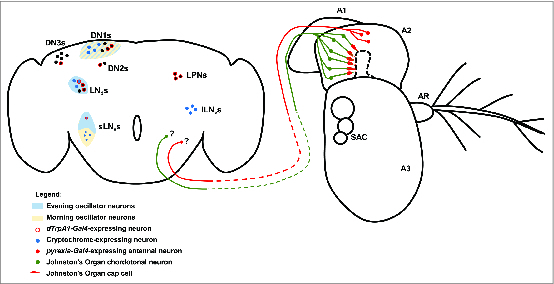Figure 5.

Central and peripheral neural mechanisms for circadian entrainment to temperature. The adult Drosophila brain and antenna are schematized here, with colored circles representing neuronal cell bodies, colored lines representing axonal connections, and colored diamonds representing presynaptiC-terminals. Shaded areas are used to represent morning and evening oscillators in the circadian circuit. Unidentified pyrexia-Gal4-expressing neurons of the second antennal segment (A2) project to the brain and potentially provide input to central circadian pacemakers via unknown synapses. Chordotonal neurons in Johnston's Organ of the second antennal segment and also in the body (not shown) are associated with Pyrexia-expressing cap cells and provide input to the central circadian pacemakers via unknown synapses. The morning oscillator (cream shading) is comprised of 4 of the small ventral lateral neurons (sLNvs) and a subset of the first group of dorsal neurons (DN1s). The evening oscillator is comprised of the fifth sLNv neuron, the dorsal lateral neurons (LNds), and a subset of the DN1s. Cryptochrome functions as the central nervous system photoreceptor of the circadian system and is expressed in the sLNvs, the large ventral lateral neurons (lLNvs), a subset of the LNds, and a subset of the DN1s. dTRPA1 functions as a component of a central nervous system temperature sensor for the circadian system. dTrpA1-Gal4 is expressed in the lateral posterior neurons (LPNs) as well as subsets of the sLNvs, the LNds, the DN1s, the second group of dorsal neurons (DN2s), and the third group of dorsal neurons (DN3s).
